Several board games on the market allow you to play alone and I have looked into what are the best solo board games on the market for 2023.
We are social beings and by nature, we tend to seek the closeness of others to work and play together. But sometimes, especially in the fast and wild modern world, the circumstances don’t allow us to get together as often as we would like. Or maybe you just want some time alone (that too is a value these days) to play at your own pace.
6 Reasons We Play Board Games Solo – And Why You Should Too
Table of Contents – Best Solo Board Games for 2023
| Rank | Image | Click on the title to quickly jump to that section of the article. | Tags | Check Price |
|---|---|---|---|---|
| 10 | 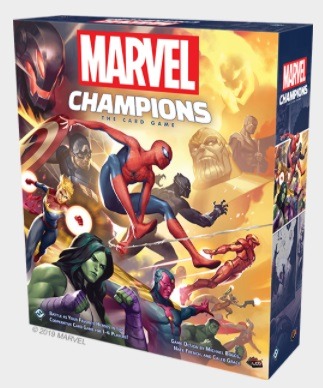 | Marvel Champions: The Card Game | living card game, deck construction, hand management | $$ |
| 9 | 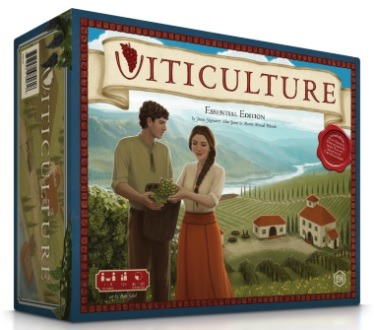 | Viticulture Essential Edition | worker placement, economic | $ |
| 8 |  | Sword & Sorcery | fantasy, fighting, action points | $$$ |
| 7 | 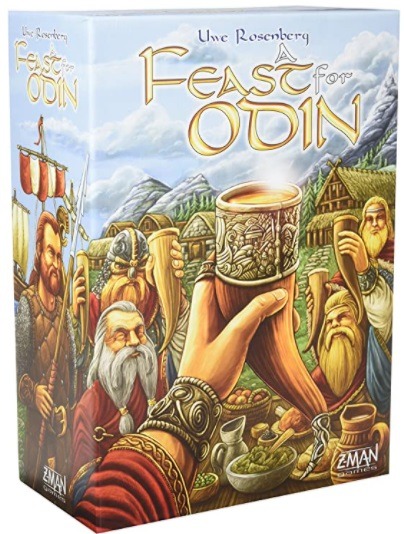 | A Feast for Odin | worker placement, Vikings, grid coverage | $$$ |
| 6 | 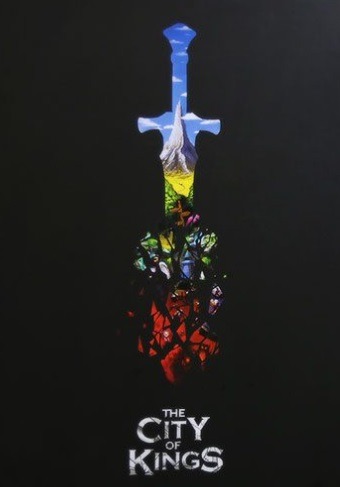 | The City of Kings | adventure, fighting, fantasy | $$$ |
| 5 | 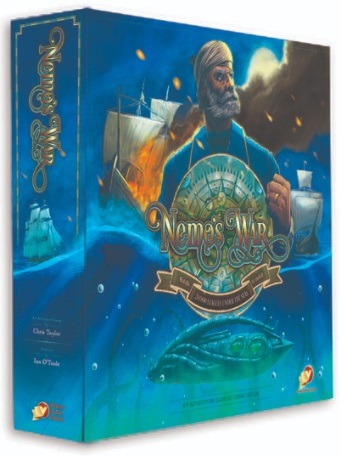 | Nemo’s War | nautical, novel-based, exploration | $$$ |
| 4 | 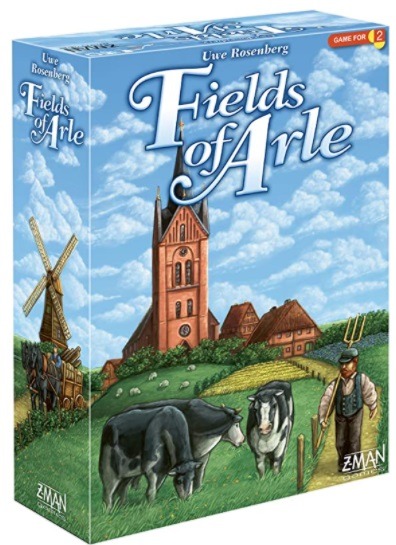 | Fields of Arle | worker placement, economic, farming | $$$$$ |
| 3 | 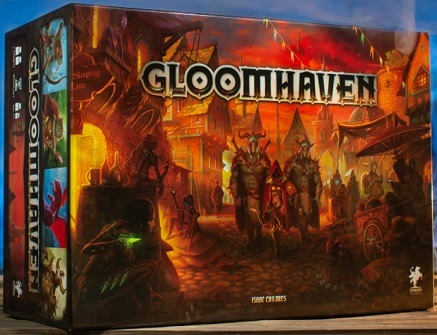 | Gloomhaven | adventure, dungeon crawling, action queue | $$$$$ |
| 2 | 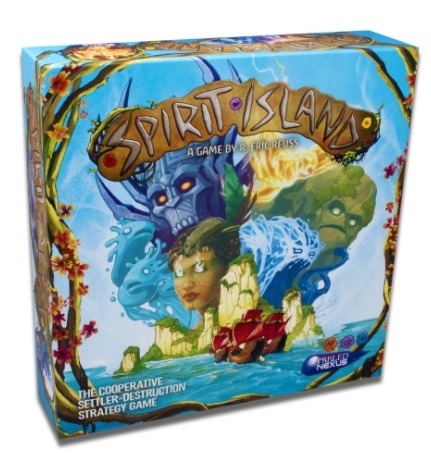 | Spirit Island | mythology, cooperative, territory building | $$$ |
| 1 | 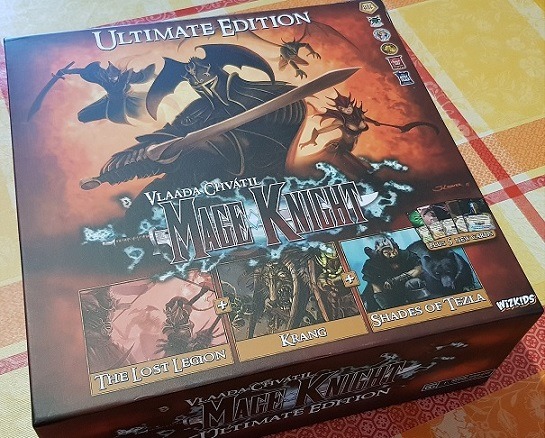 | Mage Knight | deck building, fantasy, exploration | $$$$$ |
Honorable mentions
- Anachrony just barely did not make it on the list. It’s a worker placement game with a futuristic theme. Since there are already three worker placement games on the list, I decided to stop there. But it’s nonetheless a highly rated game and if you’re more into sci-fi than agriculture, it’s worth checking out.
- It’s also worth mentioning Scythe and Terraforming Mars. Both are strategy games designed to be primarily played with more players, but also offer a decent single-player experience. Consider them, if you look for games to play with others, but would like a single-player mode as a backup.
- Kingdom Death: Monster, a combination of civilization building, adventure, and tactical combat. Highly rated, but the entry price is very high. It’s a niche game for people of very peculiar taste.
- Too Many Bones, a dice builder role-playing game with its unique strategic use of over a hundred dice. Again, highly rated, but expensive.
- This War of Mine. Experience of civilian survival in a city under siege. Adapted from the video game of the same name, it is inspired by the events of the Siege of Sarajevo in the 90s. A frustrating and depressing experience is well represented by game mechanics and presentation.
10. Marvel Champions: The Card Game

Players: The box provides enough cards for four players, but the community recommends playing with no more than 2 or 3 players. Besides that, the game also works very well in a single-player mode – that’s why it’s on this list.
Playing time: 45-90 minutes, depending on the number of players and scenarios selected.
Complexity: medium
Theme and setting
Marvel Champions: The Card Game was released in 2019 by Fantasy Flight Games. It was well-received and became a fan-favorite quickly. As you might have guessed, it’s set in the Marvel universe and its heroes (like Spider-Man and Iron Man) fighting a villain as a theme. Good vs. Evil.
Every player chooses one of the Marvel Universe heroes to play as. The villain is chosen by whatever scenario players select. There are numerous scenarios available and each can be adjusted further, so they do have replay value.
Villain’s goal is to defeat all the heroes or advance its villainous schemes to completion. It’s the hero’s task to stop him from doing that. That’s done by using your hero directly, playing boost cards, and activating helpers. The villain will also call up his minions, boost cards, and play further schemes.
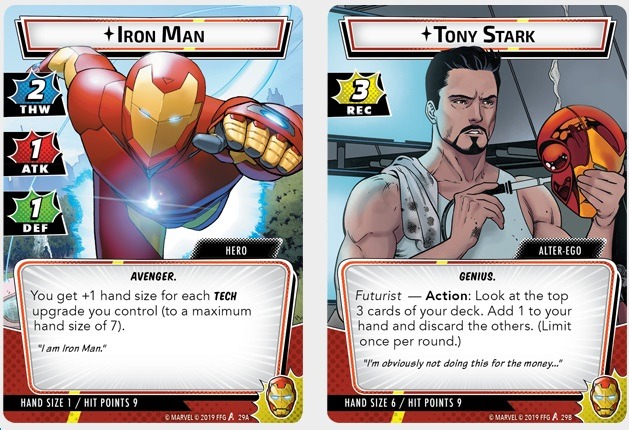
How Marvel Champions is played
The game is played in rounds and each round is divided into two phases: the player phase and the villain phase.
In the player phase, you can:
- play cards from your hand,
- trigger actions,
- attack the villain or his minions, thwart threats, or recover hit points,
- change your form: you’re either in hero (can attack or thwart) or civilian form (can recover hit points).
At the end of the player phase, all players can discard cards (there is a hand limit), draw new cards, and ready up their exhausted cards (cards that have already been used but can be used again).
Villain’s phase is next:
- Threats are placed on the main scheme. If they reach a threshold, another scheme comes into play. If the final scheme reaches a threshold, players lose.
- The villain will now attack players (who are in their hero form) or place more schemes (for players in civilian alter-ego form).
- Each player also draws an encounter card. These are further setbacks and must be resolved right away.
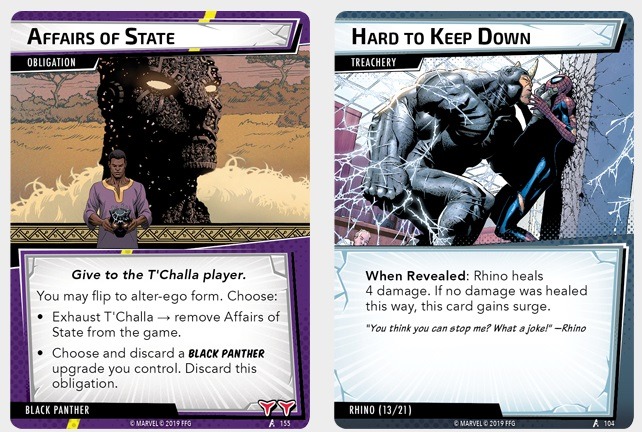
For similar games, check out Arkham Horror LCG and Lord of the Rings Card Game.
Who Marvel Champions is for?
At its core, Marvel Champions is a living card game. Although the base box has plenty of content, expansions are already available:
- Hero packs (each 60 card deck introducing a new hero, along with hero-specific cards and other cards),
- Scenarios (introducing new villains and their schemes) and
- Story boxes (larger packs with a combination of both above).
Marvel universe is a modern-day fairy tale with a huge fan base all over the world. It’s not a surprise, that Marvel Champions has had so much success already.
But it’s not all down to that: it’s a fun card game with sound, challenging, but fair and well-balanced game mechanics. If you’re a fan, you will enjoy this a lot – and for a long time into the future, too.
9. Viticulture Essential Edition

Players: It’s made for 1-6 players and it works well with any of those numbers. The single-player mode is played against an AI opponent, called “Automa”.
Playing time: 45-90 minutes, depending on the number of players.
Complexity: medium
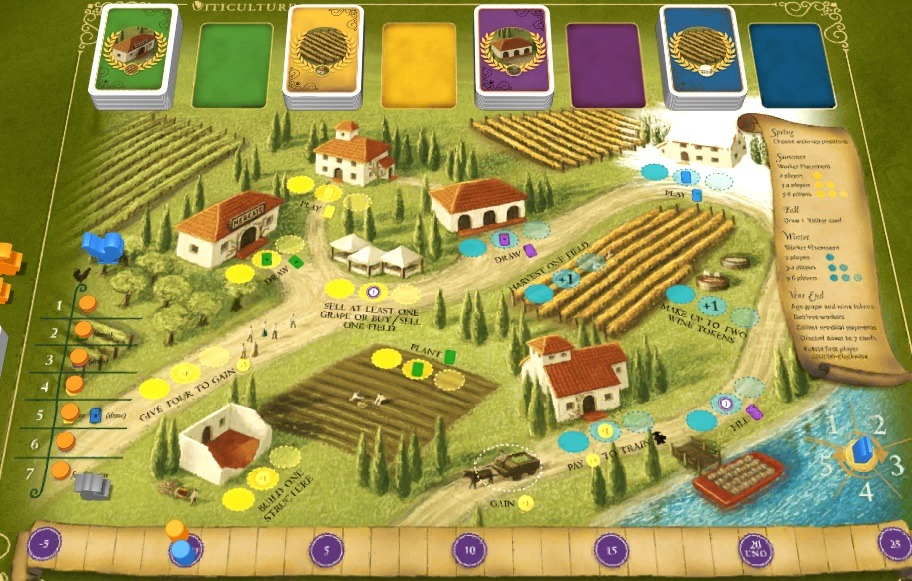
Theme and setting
Viticulture was originally published in 2013 by Stonemaier Games and designed by Jamey Stegmaier (best known for Scythe, a strategy game set in an alternative 1920s diesel-punk Eastern Europe). Essential Edition was brought to light in 2015. On top of the base game, it contains some elements of the Tuscany expansion, revisions, and a single-player Automa mode.
It’s set in the vineyards of pre-industrial Tuscany, where players try to manage their vineyards and cellars as best as they can, to eventually fulfill wine orders and increase their reputation (victory points) to become the most prominent winemaker around.
How Viticulture is played
At its core, Viticulture is a true eurogame. It’s a combination of worker placement (on the mainboard), together with engine building (on your vineyard board).
Each game begins by assigning parents to players (literally). Every player receives a Mama and Papa card and they determine what your starting capital (workers, infrastructure, money) will be. A heritage, if you will.
Each round is divided into seasons:
- Spring determines the order, in which players will place their workers by placing their rooster tokens on the Wake-up chart. You can choose to wake up early to be the first to place the worker in the desired spot, or wake up late and reap extra bonuses (gain 1 victory point or 1 worker for super late wake-up).
- Summer is the time to place your workers into one of the summer slots (draw vine cards, give a tour of the vineyards to earn money, build structures, sell grapes, plant vines or play a summer visitor card) and play out that action immediately.
- In the Fall, players draw summer or winter visitor cards. Visitor cards are cards with special one-time bonuses and are discarded after use.
- The remaining workers are placed in the Winter slots (harvest, train new workers, turn grapes into wines, play winter visitor cards, draw wine order cards and fill wine order for victory points) and the action is immediately carried out.
The year ends and wine ages. Workers are re-set and another round begins with spring until one of the players reaches 20 victory points.
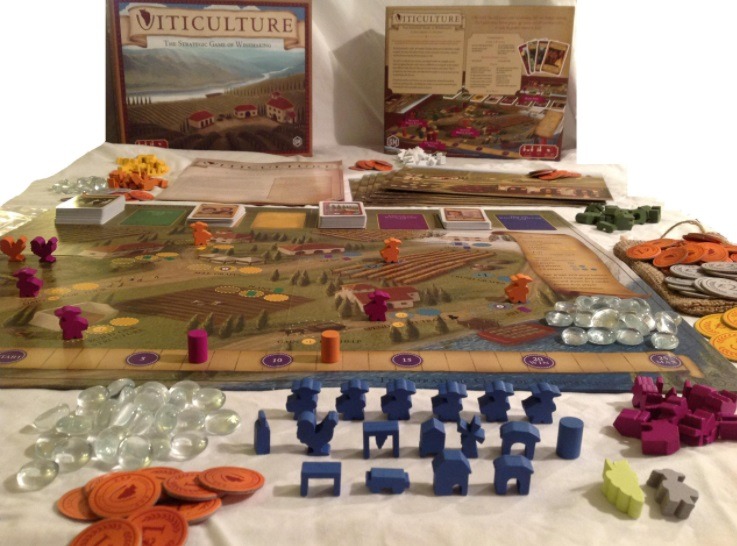
Spicing it up
There are a few things to spice the game and add diversity to available strategies:
- Grande workers can be placed in occupied slots.
- Different vine sorts (like Malvasia, Pinot, Merlot, Chardonnay, and others) of different values and various prerequisites like Irrigation or Trellis.
- On your player mat, several structures can be built, each enhancing your wine-making abilities (Trellis, Windmill, Irrigation, Yoke, Tasting Room, Cellars, and Cottage).
- When a field is harvested, it will produce grapes (according to the vine card) and the grapes can be sold or made into wine tokens. You must have a certain combination of grapes and structures to create blush, sparkling, and other high-valued wines.
- At the end of each year, both grapes and wine age – they gain value. It’s worth considering whether to sell right away or save them for next year(s).
If you like peaceful board games, check my list of Best Farming Board Games.
Who Viticulture Essential Edition is for?
The peaceful and laid-back wine-making theme suits the Viticulture Essential Edition very well. It’s for a wine-loving strategist who enjoys a good challenge.
On the other side, the rules are simple enough for anyone to pick up. It’s rightfully considered one of the best worker-placement board games.
8. Sword & Sorcery

Players: 1-5, best played with no more than 3 heroes. One player can control multiple characters.
Playing time: 60-90 minutes per scenario, also depending on the number of heroes and players.
Complexity: complex
Theme and setting
The kingdom is in trouble, evil is on the rise and it’s time to call in our champions to defeat it. You know the drill, you’ve heard it a thousand times before in these fantasy games. You play as a group of those heroes, crawling through dungeons, slaying enemies, and unraveling the story of the campaign.
Sword & Sorcery is a cooperative dungeon crawler. Your group can contain up to five heroes, but the game becomes a bit chaotic with that many (since more enemies are spawned when there are more heroes). Two or three heroes is an ideal number.
That does not mean you need the same number of players as you have heroes. You can play alone and control all the heroes yourself – which is a pretty good experience.
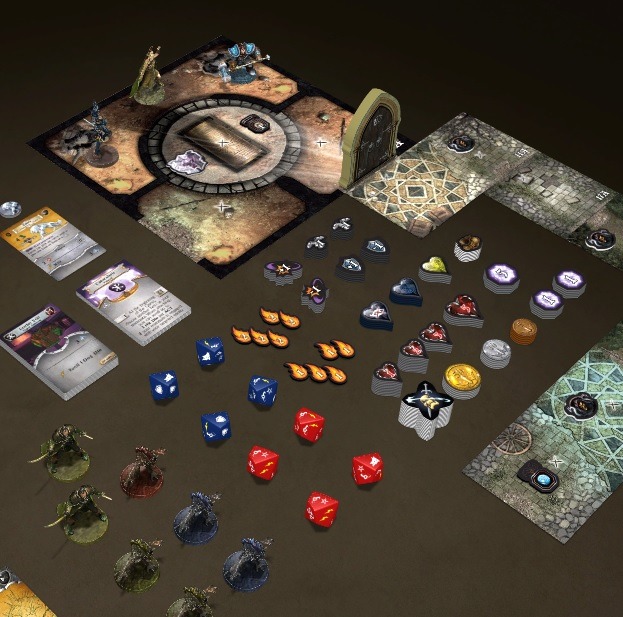
How Sword & Sorcery is played:
Sword & Sorcery is a narrative campaign game. There are seven scenarios in the base game and you should play them in order since they are connected by the story.
After the flavor text, you set up a dungeon, as is instructed in a scenario, and after you complete it, go back to the storybook and read what happens next.
A scenario consists of a dungeon, that you must clear of monsters. By doing that, you’ll also discover weapons, items, and secrets helping you on your journey.
What you can do in a turn is dependent on your hero’s stats, but usually, your turn will go like this:
- Move for a certain number of tiles.
- Combat enemies.
- Perform actions like dash, focus attack, open chest, open door, and pick up or drop items.
After each hero’s turn, it’s the enemy’s turn. You draw Encounter cards to determine how many of them will activate, and then they will be controlled by their cards, which act as a very clever artificial intelligence.
Depending on the distance to heroes and what items certain heroes carry (some creatures like to attack wounded heroes and other target heroes that have coins on them), conditions on the card will tell exactly what to do: move, attack, range attack, etc.
Combat (attacking and blocking) is resolved by dice. But it’s not down to just luck, there are shields, armor, weapons, and abilities that all have weight on the dice and you must take them into account.
A player with good armor can still be hit if the dice fell the wrong way, but it’s much less probable than if he had none, so your decisions matter. I think they’ve hit the sweet spot with how much luck affects the game – it brings excitement and uncertainty but it’s not a rule-all.
This creates great cooperative gameplay, where you have to plan ahead, depending on your characters and map. You also can’t play it too safe and risk running out of encounter cards, because then you lose the game. Sometimes you just have to take a risk and move into an unexplored room to see what you wake up.
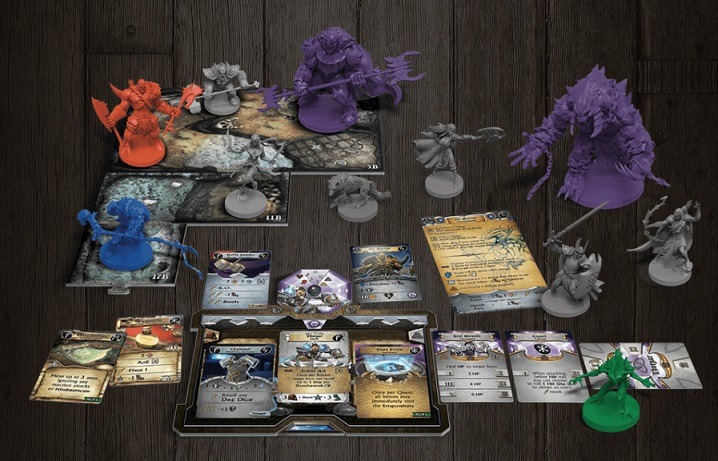
Who Sword & Sorcery is for?
Sword & Sorcery is for people looking for a dungeon crawler with good combat mechanics, good AI, a good progression system for heroes, and a good (although a bit cliche) narrative. It’s also a very good single-player experience. Trying to juggle three heroes and their abilities, to work out how to defeat a dungeon, bring home loot and stay alive is quite an undertaking.
The game’s main drawback is the number of scenarios in the base game, especially if you compare them to something like Gloomhaven.
7. A Feast for Odin
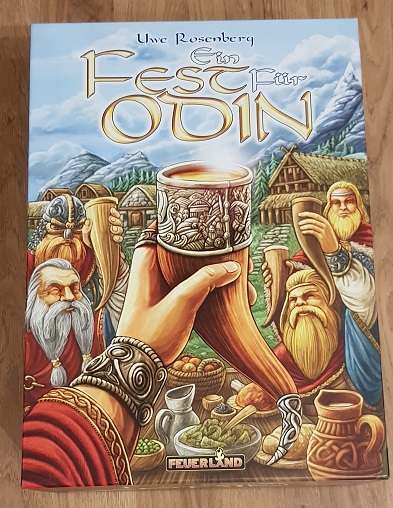
Players: 1-4, it works well with any number of players.
Playing time: 30-60 minutes, depending on player number and length of the game (short and long variants exist).
Complexity: complex
Theme and setting
Another of Uwe Rosenberg’s blockbusters, A Feast for Odin from 2016 is Viking flavored. You control a Viking tribe, farming, hunting, exploring, and raiding – and eventually building up their home board with items they salvaged or produced.
The goal of the game is to score as many points and this is done by covering your negative points squares on your home board (and other boards you take on during the game) with the salvaged items. The more points and more effectively your cover them, the more points you have at the end.
Is a Feast for Odin difficult to learn and play?
Why A Feast for Odin is an Excellent Solo Board Game – 3 Reasons
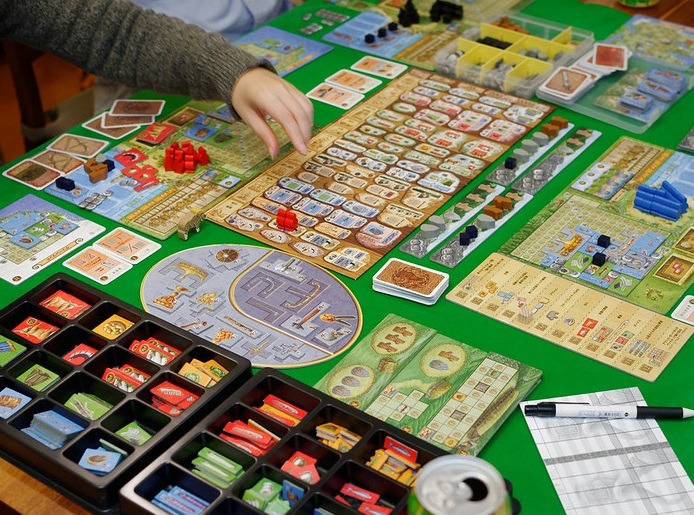
How A Feast for Odin is played
A Feast for Odin is a worker placement game with a lot of options – to be precise there are 61 choices when placing a worker. But don’t be scared of that. Actions are categorized into sensible groups (like building ships and houses, hunting, managing livestock, producing resources, sailing, and occupying new lands) and many of them do the same thing, only with different resources and/or at different levels.
The game is played in 6 (short game) or 7 (long game) rounds and each round is divided into 12 phases. To help players, a handy guide card is provided, describing the phases. So you can just play by that guide and be perfectly fine:
- New Viking. Take one Viking from the Banquet table (we’ll talk about that in phase 9) and place it on your Thing square (available Vikings for action). Each round you have one less Viking on the Banquet table and one more for action.
- Harvest. You receive food: peas, beans, flax, grain, cabbage, and fruit. (Yes, there are a lot of resources.)
- Exploration. Claiming additional areas on exploration boards (Shetlands, Faroes, Iceland, Greenland).
- Draw a weapon card (you need these for hunting, whaling, and pillaging).
- Action phase – now it’s time to place your workers into action spaces, carrying out actions immediately. Each action space can be occupied only once per round, but some actions require more than one Viking.
- The player who placed the last worker is designated as the starting player for the next round.
- The income of silver is received depending on how much of your home board (and exploration boards) is covered by blue and green goods tiles.
- Animals breed – become pregnant or give birth.
- Feast. Place orange and red food tiles on your Banquet table (covering tiles as effectively as possible). You can help fill it with silver tiles. For each space you can’t fill, you get a penalty, costing you victory points at the end of the table. When the feast is over, tiles are returned to the general supply.
- Bonus. There are also bonus tiles on your home boards. If you filled out those wisely, you can now receive those goods.
- Add new Mountain strips, from which you can gather basic resources (wood, stone, ore, and silver).
- Remove Vikings from the action board to end the round and repeat the phases in the next round.
At any time, you can
- place your green and blue goods on your home board, exploration boards and house tiles,
- buy ships (small boats for whaling and longboats for pillaging) and arm them (place ore on them).
- play occupation cards (special action).
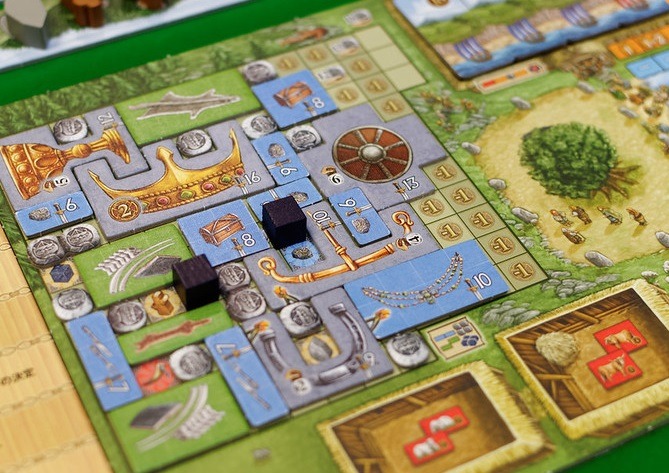
Who A Feast for Odin is for?
A Feast for Odin holds a lot of similarities with Fields of Arle: the player has a lot of different paths he can focus on or he can do a bit of everything. Both offer a lot of strategic possibilities, but Odin enhances that with exploration and tile-placing puzzles.
If you prefer the Viking theme over an agricultural, I would recommend Odin over Arle. Gameplay-wise, they are very similar and both are top-notch strategy games and you can’t miss with any of them.
6. The City of Kings

Players: 1-4, best experienced in solo (controlling 2 characters) or 2 player mode.
Playing time: 45-180 minutes, depending on player number.
Complexity: medium/complex
Theme and setting
City of Kings is a cooperative adventure board game (with elements of worker placement) set in a fantasy kingdom. Only one city still exists in this once-powerful kingdom, as everything else is taken over by the mighty Vesh. The game is played on a 4×5 tile board (the tile in the bottom left is the city from the title), which is custom-made for each scenario and placed face-down, so you can explore it as you go.
You can choose from six different characters (once great leaders from the title) and each of them has a unique skill tree as you level up. Characters will travel the board (but not diagonally), explore it, exploit the land for its resources (with the help of workers they control) and collect weapons and items, that they will need for fighting the monsters they encounter on the way.

How A City of Kings is played
During the set-up, you will select either Story (7 available) or Scenario (12 available) and set up the tiles for the board according to the instructions provided by it. There are different types of terrain tiles with different features and as you reveal them, they will provide resources, quests, items, spawn monsters, etc.
As you encounter creatures, you draw a creature card from a deck, its stat bar from another deck, and a special ability from a sack. This means every creature is unique and it also gives way for some interesting combinations to appear. Like a dragon-type monster with a freezing ability instead of the genre-norm expected fire-blowing capabilities.
The game is played in rounds, and each round consists of three stages:
- Resolve impairments (like effects of fire and poison if any of those are on the map)
- Activate creatures (they will heal, attack, move and use their special abilities)
- Hero and worker actions (by using 4 action tokens). A hero can move, explore, attack, heal, perform special skills, and interact with special tiles, while workers can move, explore, or work (gather resources).
Resources that are gathered by workers, are shared by all the characters and can be used to buy new equipment or to upgrade certain buildings on the tiles. Another collective thing among the characters is experience and leveling up. They all share the same XP table and progress together.
Rounds continue, until the player(s) complete the objective provided by the scenario. Or, if they run out of Hope or Morale, they lose.
Who The City of Kings is for?
The City of Kings is a peculiar character. An adventure, using worker placement mechanics as your action points is a unique approach.
Combine this with monsters, that are always unique and random, combating them creates a puzzle, unlike any other board game. Fighting them is a tough cooperative challenge and every one of them demands a different approach.
I’d suggest The City of Kings to seasoned adventurers and dungeon crawlers, who are seeking something fresh.
5. Nemo’s War

Players: 1-4, but it’s meant to be played as a single-player game.
Playing time: 60-120 minutes
Complexity: medium/complex
Theme and setting
Nemo’s War is based on Jules Verne’s classic novel, Twenty Thousand Leagues under the Sea. It’s about Captain Nemo and his famous submarine, the Nautilus. It is a game of underwater exploration, combating vessels, wrestling the sea, and seeking wonders, secrets, knowledge, and vengeance.
How the game is played out, is heavily dependent on Nemo’s motives. There are four available: War!, Explore, Anti-Imperialism and Science. They provide scoring multipliers for victory points, obviously scoring more points for actions, relevant to their flavor. How many victory points you accumulate, determines if your game was a success or not.
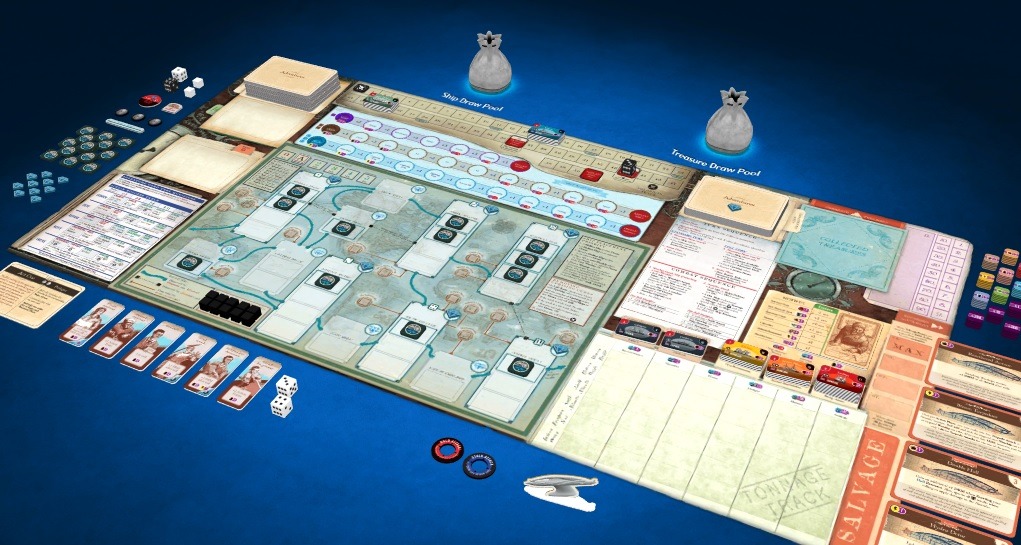
How is Nemo’s War played?
The game is played in a series of rounds, and each round is made of 3 phases.
- Event phase, where you draw an adventure card and immediately resolve it. This phase progresses the story.
- Placement phase where according to the two rolled dice, you place ship tokens on the oceans. The difference in numbers on the dice also represents the number of action points, you get for the round. (If you roll doubles, you can end up in a special Lull turn, where you place treasures and uprising cubes.)
- The action phase is the meat of the game and it’s time to spend your action points here. In this phase, you have options to:
- draw another adventure card from the deck.
- attack ships (bold or cautious attacks + torpedo attack, once you have that upgrade) – combat sequence is initiated to determine the outcome.
- incite uprising, if there is an uprising cube available.
- move to an adjacent ocean
- rest to gain crew points
- repair to gain hull points
- refit (upgrade): double hull, fog machine, hydro drive, magnetic mines, periscope design,
- search for treasure.
If you don’t spend all the action points, you can transfer one to the next round.
It is worth mentioning that performing most of these actions is not a given – many of them must go through a test sequence to see if they succeed. This is done by rolling a die against a table, and you can spend resources (hit points) to add to your throw and enhance your chances.
Victory Conditions
The game is played until you are defeated:
- you lose your hull hit points,
- you lose crew hit points,
- Nemo’s sanity points,
- or the oceans become overwhelmed by ships.
Or you reach the Finale cards, that instruct you to end the game. Depending on your victory points, the manual will tell you if you won and to what degree.
Sunken ships fill up the Tonnage table. How much of the table you fill out, directly affects the number of victory points you get at the end. But if you are not careful at sinking, it can affect your notoriety, which is another way to lose.
A lot of the outcomes in Nemo’s war are affected by dice. You indeed have a level of control over them, but in the end, it’s a moderately luck-dependent board game. But it’s not really about luck or all the intricate game mechanics that run this game.
This is about you being Captain Nemo and reliving his adventure through your own experience. As such it’s an exceptional experience, especially if you play in solo mode, which is what it is primarily designed for. It does not work well if there is more than one player playing.
Who Nemo’s War is for?
Event cards that you draw during the game put you on an epic adventure, paralleled only by Jules Verne’s novels. If you read his novels at a younger age and found them fascinating and immersive, you will feel the same thing playing Nemo’s War.
4. Fields of Arle

Players: 1-2. Works best with 2 players, but the single-player experience is exceptional, as the game is more about building your farm, rather than competing against the other player.
Playing time: 60 minutes per player
Complexity: complex
Theme and setting
Designed by Uwe Rosenberg, a well-known and respected board game designer (titles like Agricola, Caverna, Le Havre, Glass Road, Patchwork, and many others), Fields of Arle was published in 2014.
The game is set in the small town of Arle, East Frisia (that’s in Northern Germany, where Uwe originates from) where one or two players take on the role of farmers in a past era of great economic opportunities. Can they make the best of the town’s prosperity and make their farms flourish as well?
You can take your farm in any direction, you desire: grow flax and grain, breed animals, cut peat, colonize the moor, build dikes, cultivate forests, run a vehicle fleet, and build buildings like workshops or inns.
Fields of Arle is played over four and a half (game) years, where each year is divided into summer and winter. At the end of the 9 rounds, there is a scoring round to determine the winner. In a single-player game, the goal is to score as many points.
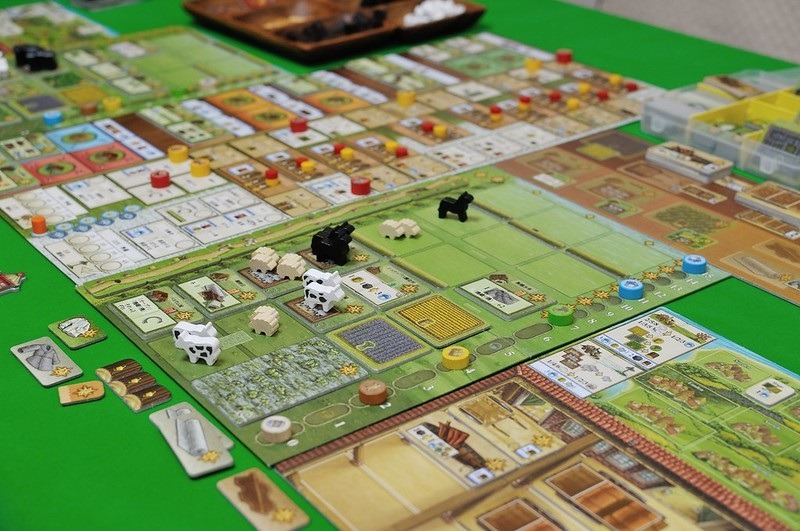
How is Fields of Arle played
At its foundations, Fields of Arle is not a complicated game. On each of the nine seasons, you place your workers into available summer or winter slots on the mainboard, deciding what to do – affecting your home board and enhancing your engine. When a season ends, planned winter/summer events take place. The devil, of course, is in the details.
Some available summer jobs for your workers are:
- Fishermen fish for food.
- Colonists can dehydrate a moor tile.
- Woodcutter produces wood depending on your axe tool marker.
- Builders can build a building if you can afford its costs.
- Peat cutters can cut peat out for moors depending on your spade marker.
- A farmer can build a plow and plow (make) a field with it.
- Master can boost your tool rating markers.
- Woolen weaver can make wool into woolen depending on the number of weaving looms you have.
- Dike builders can build more dikes and expand your territory.
- A forester can plant forests.
- Carpenters can build buildings or stalls.
- A laborer can build vehicles like carts, carriages, and peat boats.
After that, the end of summer events take place:
- Empty vehicles with goods you have placed there during your turn (you can do that anytime) and receive corresponding travel destination tiles (these count for victory points at the end).
- Milking – you receive food depending on the number of animals you have.
- Harvest – you receive grain, flax, and wood in your fields and forests.
- You pay maintenance (food and peat).
And winter jobs:
- Peat boatman produces peat.
- Butcher slaughters your animals and turns them into food and hide – depending on the number of slaughter tables you have.
- Carpenter can build a stall or exchange a stall for a stable.
- Tanner can convert hide into leather depending on the number of fleshing beams
- Cattle trader produces grain and sheep, together with cattle or horses.
- Potters can convert clay into food and peat depending on the number of pottery wheels.
- Master can improve your tools by moving one of your tool markers.
- Linen weaver converts flax into linen depending on the number of weaving looms.
- Baker converts grain and peat into (a lot of) food depending on the number of ovens.
- Wainwright can build vehicles.
Ending with the end of winter events:
- Empty vehicles, just like in the summer.
- Receive baby animals according to the number of animals you have (they must be paired up in stables).
- Sheep are sheered for wool.
- You must pay food for maintenance.
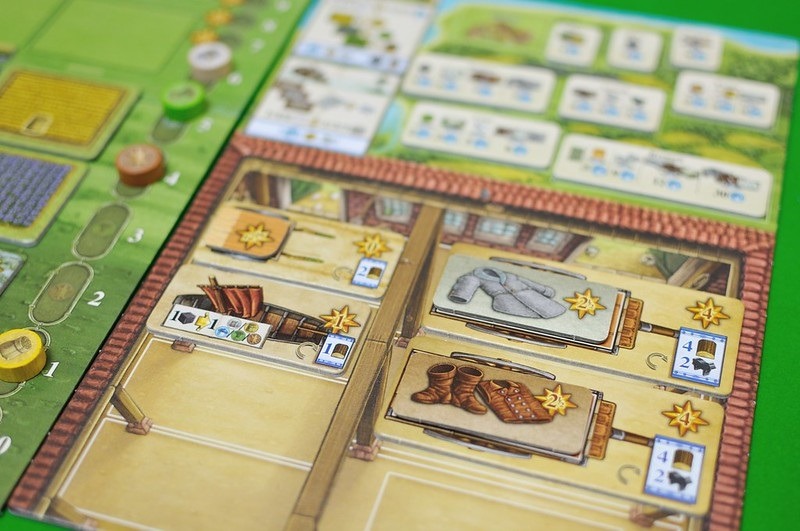
Farm it your way
As you can see there are a lot of things to look after – but only if you wish to do so. Expand your territory by building dikes and dehydrating moors, cultivate those lands by plowing them, plant forests, and construct stalls and buildings. And then exploit this land and animals for resources, deliver them to cities and fill your pockets.
But you don’t have to do all of this. You can highly specialize your farm and do whatever you want: have a lot of sheep and sell woolen, go for leather, build carriages, buildings. There are endless possibilities limited only by your imagination.
When all nine seasons are over, it’s time to wrap up the scores and see how you did. Almost everything you did and own is taken into account: materials, vehicles, travel experience, goods, victory points from dikes, tools, and animals.
Who Fields of Arle is for
If you played that farming game on Facebook and loved looking at how your crops and your little farm grow, you will find a lot of enjoyment in Fields of Arle. It’s a very peaceful game, not so much designed to be played competitively, but to relax and let your inner farmer loose.
3. Gloomhaven

Players: 1-4
Playing time: 60-120 minutes per scenario.
Complexity: complex
Theme and setting
If you’re into board gaming and haven’t heard of Gloomhaven, you must have been living under a rock for the past few years. The game was published in 2017 after a very successful Kickstarter campaign. It’s currently ranked number one on BoardGameGeeks (the most comprehensive online board game database) overall list.
Gloomhaven is a narrative-driven tactical role-playing dungeon crawler placed in a fantasy world. You will explore the world, clear the dungeons, improve your abilities with experience, find, buy and sell items and loot, and discover the story, depending on the decisions you make.
The bulk of the game is scenarios (95 included in the base game), connected by the story. Each of them includes some narrative and a dungeon to clear. That’s what you’ll be doing most of the time – clearing out dungeons in tactical combat.
Players play unique characters with their own set of skills, abilities, and agendas. Characters level up, improve, and grow during the scenarios, so players can feel connected to them. The world also changes depending on how characters progress and what decisions the players take.
Unlocking new stuff comes in mysterious envelopes, so you never really see all of the game’s components and you only open them, when you advance that far. It’s always something new and exciting to look forward to.
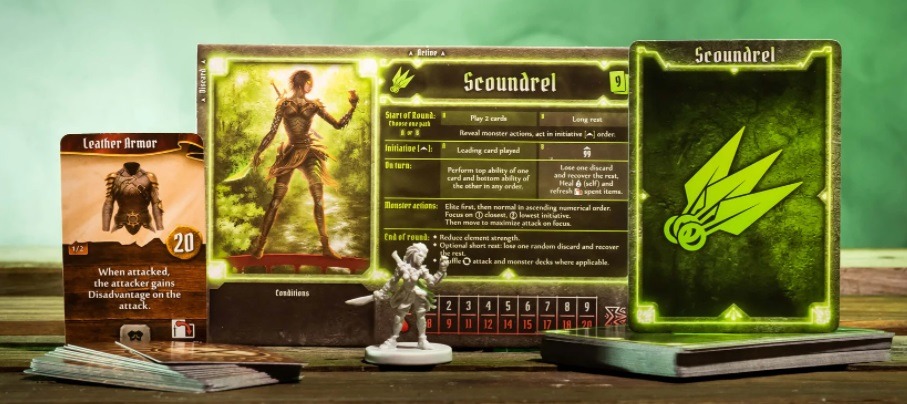
How Gloomhaven is played
The gameplay is divided into rounds. Gloomhaven uses very clever action card mechanics for characters.
Characters start a scenario with a predetermined number of action cards in their hand (depending on the character, it’s usually around ten): everything from moving, fighting, looting, and healing is decided by these action cards.
Each character plays 2 action cards per round and reveals them face-up. Initiative numbers on the cards determine the order of play.
Including monsters, cards are played from the lowest initiative value to the highest. Actions are carried out immediately with attacks affected by combat modifier cards. (You can modify this deck to your liking!)
Action cards have top and bottom action (typically – but not always – the top being for attacking and the bottom for moving) and you have to decide on one top action and one bottom action from each card. Used cards are discarded, and you can only regain them by resting, but that means you have to give away one of the cards for good. But beware – if you run out of action cards, the scenario is over for you – you are exhausted.
Deciding what combination of cards to use, when to use them, and what is the most effective way of doing that, is the core of Gloomhaven’s gameplay, and looking at it from a distance it’s a giant puzzle. How do you come through a dungeon with your hand?
Combining cards is what you’ll be doing in Gloomhaven for the vast majority of the time. Fortunately, it’s an excellent game mechanic and a very enjoyable challenge, disguised in an immersive adventure.
Monsters are controlled by drawing from an artificial intelligence deck of cards, so you’ll never know how exactly to approach a certain monster since it can behave differently from last time.

Who Gloomhaven is for?
Gloomhaven is a gigantic game. It’s made of hundreds of components and just setting up a scenario, sorting everything to its place, can be quite a daunting task. The gameplay itself is smooth, but it’s very mentally demanding on the players. There are hundreds of small rules you have to take into account, and you’ll find yourself constantly going back to the rule book for clarifications. The game is challenging, but you can set the difficulty lower if you find it too hard.
If you’re a hardcore enthusiastic gamer that has (both physical and mental) space and time, Gloomhaven is the best available. Solo experience is also brilliant – pick a couple of characters and enjoy watching them grow, change the world, and engage in an innovative combat system.
If you like the idea of Gloomhaven but are scared away by the number of components and complexity, look up for Jaws of the Lion, its younger brother. Gloomhaven: Jaws of the Lion takes the best bits of Gloomhaven, simplifies the rest, and makes itself accessible to less-hardcore players.
2. Spirit Island

Players: 1-4, although with 3 or 4 players, the game becomes a bit chaotic.
Playing time: 90-120 minutes
Complexity: complex
Theme and setting
How many times have you played a game where you have to colonize a previously uninhabited land? The land belongs to no one and just lays there, ready to be claimed by settlers or an invading force.
But what if the land does have an owner? What if it’s owned by nature or by spirits of nature who would prefer nothing more, than just being left alone? In Spirit Island, you play as one of those spirits, fighting humans from colonizing your island, your home. Can you scare the invaders enough that they will leave you be, or will they overwhelm you?
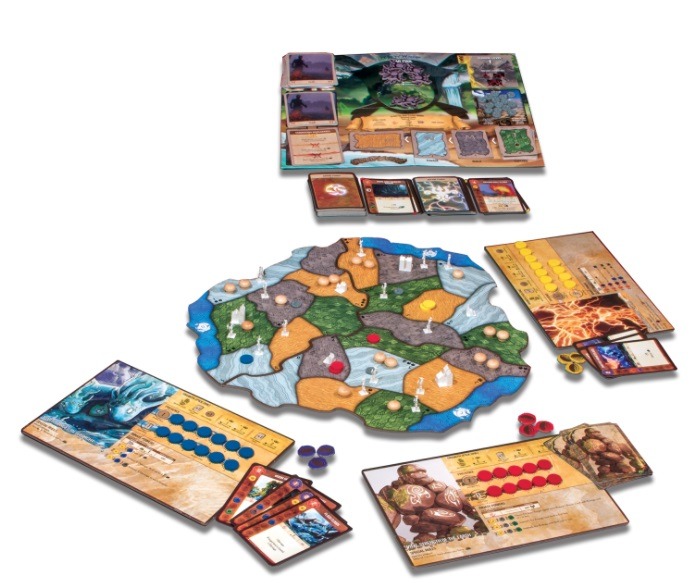
How is Spirit Island played
Spirit Island is a cooperative game, where players (or one player) fight against the game, in this case, invaders. The board is modular and its size depends on the number of players. Each player takes on a role of a spirit, and every spirit has its characteristics – some better at scaring, others at natural elements like tsunamis and crop diseases, or handling the island natives (your allies) the Dahan, and so on.
Invaders can come from different European countries – again with different styles of invading and difficulty. For more of a challenge, you could turn over the map to its thematic side or use an optional scenario, altering victory conditions. All these set-up combinations are well explained in the rules, so you can easily select the difficulty you want to play at. With eight different spirits to choose from, you are in no fear of running out of options.
The game is played in rounds until either side wins. Each round, you (as spirits) decide what to do (growing, gaining energy, playing cards), and then invaders answer by exploring and ravaging the land, building towns, and cities. This is done by drawing terrain cards, very similar to Pandemic, but with a lot more depth and options.
Your spirit powers and destruction of towns and cities generate Fear and terror in invaders. Generating enough fear, so that the invaders have no wish to venture onto your island further, is your main tool to victory.
On the other hand, if the invaders overrun you, destroy your spirit or their invader card deck runs out, you lose.
Spirit Island
If you enjoy a game, where you fight towards a common goal, but wish for a complex experience with a lot of strategic options, Spirit Island is the game you’re looking for.
Similarly, if you wished you could play alone, Spirit Island works excellently as a single-player experience.
1. Mage Knight

Players: 1-4, best played solo.
Playing time: 60-240 minutes, depending on the scenario.
Complexity: complex
Theme and setting
In Mage Knight, players play as powerful wizards/warriors, named mage knights. You will explore and roam around a beautiful hexagonal-tiled landscape full of natural (forest, plains, deserts …) and artificial (villages, cities, monasteries, mines …) features, but also full of fantasy creatures that are just waiting to be fought with and defeated for Fame.
Victory conditions are determined by the scenario. In solo conquest, your goal is to conquer two cities, in competitive scenarios, a player with the most Fame wins, but in some scenarios, certain actions may produce more Fame than others. For example, if you play a scenario to conquest cities, you will get more Fame from the cities you take. Or in Mine Liberation, you take extra points for mines you clear.
How is Mage Knight played
At the beginning of your turn, you will draw a certain number of action cards (starting with five, but it will increase as you level up). They determine what you can do in a turn: move, attack, block, recruit minions, and draw mana.
Each action card has a weaker top-row action and a stronger bottom-row action. If you pay mana of aspecific color, you can use the bottom-row action. Combining these cards to achieve what you want in a turn is the core of Mage Knight.
Let’s say you want to move two tiles and attack a monster. First, you must look at the terrain (because different terrain types require different move points), to see how many move points you need. Then you look at the creature to see how much damage you need to do to defeat it.
Now you look at your cards: Do you have any move cards or attack cards? Do you have any mana to enhance a certain card? Then you try to combine the cards in a way to achieve your goal. If cards don’t allow it, perhaps you could do something else. Maybe visit a village instead and recruit a minion? Do you have enough influence cards for that?
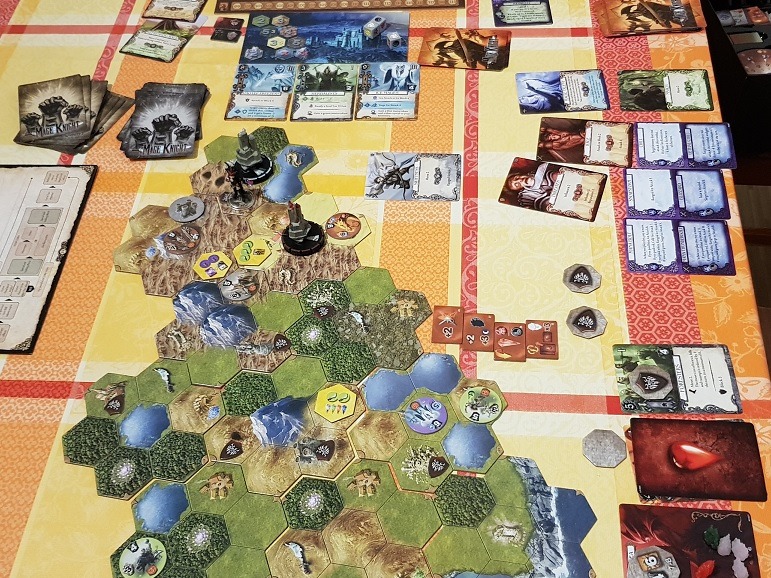
The combining is deepened by the fact that you can always use any action card sideways for one (one movement, attack, block, influence). This all together gives you a lot of tactical options and I believe it’s this deck combining that keeps Mage Knight so popular years after the release.
As you level up, you will obtain special skills, draw stronger action cards, increase your armor, ability to lead more and better minions, and become an overall much stronger Mage Knight. Not that you weren’t strong from the get-go, you are a hero after all.
Special mention must go to the day/night mechanic. When you run out of deck cards, time changes from day to night (and then back again). This changes some moving points required for terrain types (i.e. deserts are easier to move through in the night, while forests become harder), but also allows stronger spells with black (night) mana to be cast.
Read more:
- Mage Knight Ultimate Edition Review
- Mage Knight vs Gloomhaven
- Why Is Mage Knight So Good? (3 Reasons)
Mage Knight
Mage Knight is a fantasy role-playing game with deck-building mechanics, character progression, and different scenarios to play – including a superb solo mode. If you enjoy adventures, exploration, and fighting mythical creatures, you will love Mage Knight.
If possible, buy the Ultimate Edition, which comes with all the expansions already included, although the base version is currently much cheaper.
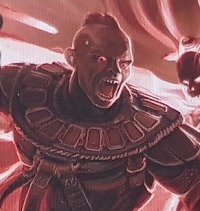
Great information, many thanks
The fact that Final Girl isn’t mentioned, completely invalidates this list.
I agree that the article is due a rewrite soon. 🙂